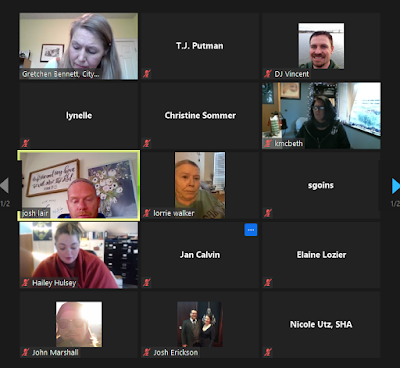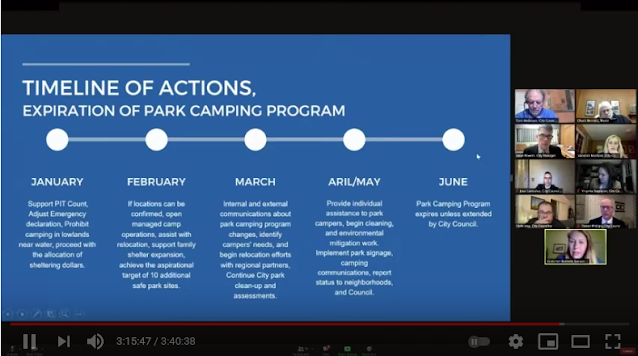By Sarah Owens and Michael Livingston
| Oregon Capitol 2021, closed due to C19 (photo courtesy Hillsboro Chamber of Commerce) |
With the Capitol boarded up (first floor windows) and closed to the public, the 2021 Legislative Session feels very different this year. But, the limited access hasn't stopped the City's Legislative Committee (Mayor Bennett and Councilors Andersen, Hoy and Lewis), who have been lobbying hard for the City's priorities since before the session began on Thursday, January 21 (House, with the Senate following on Friday).
In December, the City had seven priorities, according to the minutes of the December meeting.
Priorities. The Committee revisited priorities for the upcoming session: Yaquina Hall funding gap, operations of a navigation center, COVID-19 recovery resources, behavioral health resources, and canyon wildfire clean up, with the inclusion of a sobering center and CAHOOTS-style model for Salem. The Committee expressed a preference for seeking capital funding for the CAHOOTS model, rather than operating.Through the sausage process, the City's priorities narrowed to four: funding for navigation ($5M) and sobering ($1M) centers, Yaquina Hall ($3.1M), and "Community mental health impacts." See Thomas, J. "City of Salem is again asking the Legislature to help fund housing and homeless projects." (20 January 2021, Salem Reporter.)
This winnowing was no doubt disappointing to Councilor Nordyke, who has been very vocal in her belief that CAHOOTS is a must-have for Salem, perhaps prompting this advice in the City Manager's 1/15/21 Update:
However, at Friday night's meeting, after noting Nordyke's disappointment that the City was not prioritizing CAHOOTS, the Committee approved a one-pager for legislators that included CAHOOTS, and described the need as "$800K to cover 12 months of operations" that "assumes partnership with local organizations." (The Salem version is "CRU", short for "Community Response Unit", and is a fledgling project of the United Way of the Mid-Willamette Valley that Kim Hanson initiated when she was serving on the Downtown Salem Good Neighbor Partnership. See "Council Conducts 'Disjointed' Session on 'Non-Criminal' Policing." 22 October 2020.)
 |
| January 22, 2021, Legislative Committee |
As Mayor Bennett described the CAHOOTS ask, the City wants the state to fund the City's contribution to the United Way project, which is not something the state typically does. Thus, it would seem that the City does not seriously expect to receive CRU/CAHOOTS funding, and wouldn't know what do do with it if it did. See "News from the Continuum" (23 December 2020.)
Also this week, the City announced plans to stand up a ~10-week, ~100-space, indoor camping program at the State Fairgrounds beginning early February at a cost of $602K (that's $602 per camper per week at capacity) ($250K from MWVCAA's share of "Out of the Cold" state program funds --see "State Policy Pits BLM vs. Homeless" (4 January 2021) -- and $352K from the City of Salem -- see "Council OKs $1.2M for Homeless Relief" (10 November 2020).
The City's announcement (press release, Community Connection, etc.) gives the impression that the program is part of its plan to "carefully conclude overnight camping" in Wallace Marine and Cascades Gateway parks, but it really isn't.
Note that the City's communiques erroneously cite the City's Emergency Housing Declaration as responsible for lifting the park camping restrictions. In fact, it was the City's C19 Emergency Declaration that did that. (City of Salem Resolution 2020-18 prohibited public gatherings on public property and suspended the camping ban in Wallace Marine and Cascades Gateway parks.)
The distinction is one that Salem City Manager has been at pains to maintain, doubtless due to the need to maximize the chances that the camping programs, if they can be called programs, can be paid for with CARES Act or other federal funds. But, if social media posts are anything to go by, there has been an unfortunate tendency to conflate Salem's C19 policy decisions with its homeless policy decisions. In other words, too many Salem residents believe that City homeless policy has somehow changed from what it was in 2019. They don't realize the City's 2020 decisions to incur costs in support of camping were prompted in large part by pandemic realities, and very likely would not have been taken without the potential for federal reimbursement. Once pandemic conditions come to an end, it's highly likely that the City's willingness/ability to fund homeless camping programs will also come to an end.
In preparation for that day, the City is currently participating in a League of Oregon Cities work group that is "seeking enforcement options for public spaces" in the wake of Boise v. Martin. Because, even if the legislature gives Salem another few dozen supportive housing units and another few hundred low-barrier shelter beds, people are still going to be trying to find a place to pitch a tent. The alternatives are not nearly as humane as people like to think, and there are just too many people living in the streets. The Mayor likes to insist that Salem is not going to become Portland, but it's just a question of strategy and scale, especially as one considers that "seeking enforcement options for public spaces" is exactly where the City left off 2019. See "Camping Ban for Christmas" (21 December 2019) and Kavanaugh, S. "Portland Mayor Ted Wheeler’s urgent mandate to move homeless campers into ‘humane’ shelters isn’t working." (23 January 2021, Oregonian/OregonLive.)





















